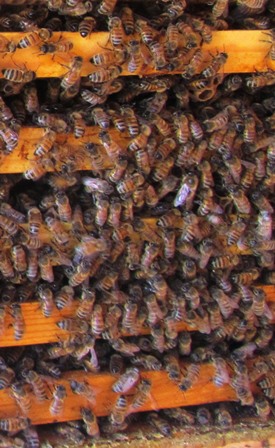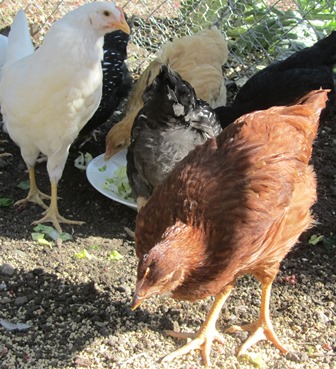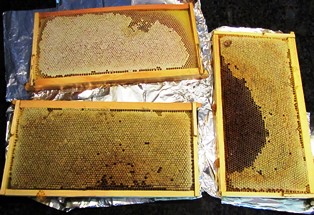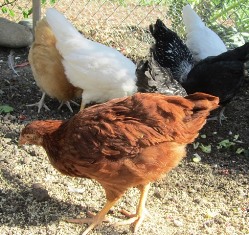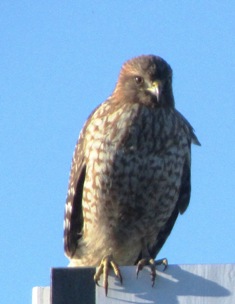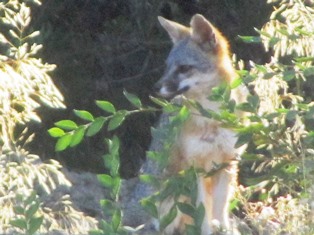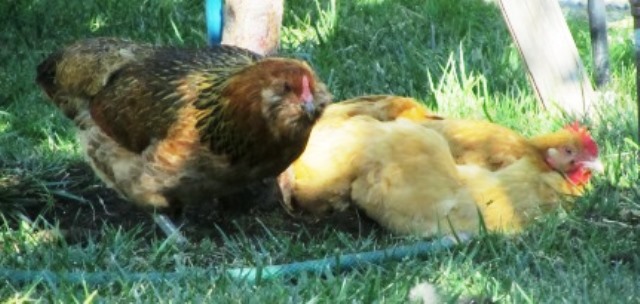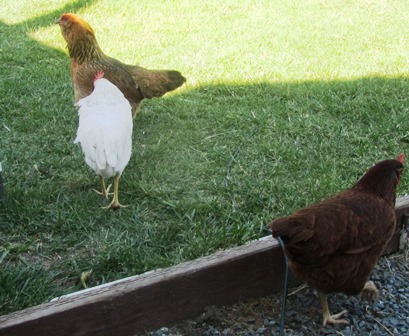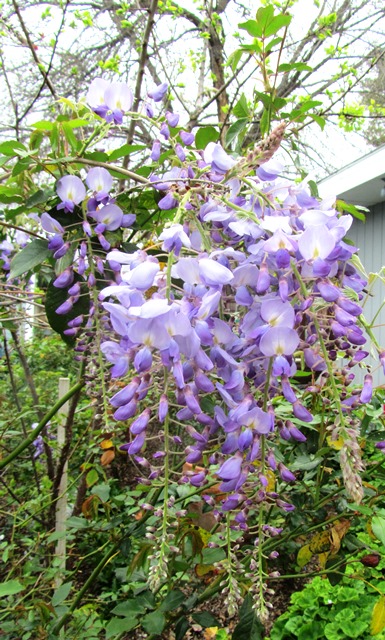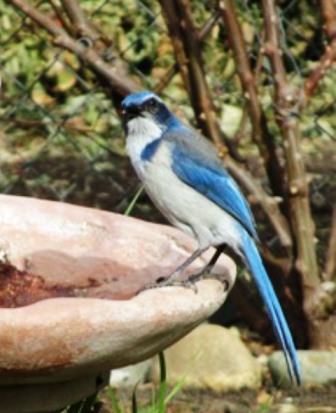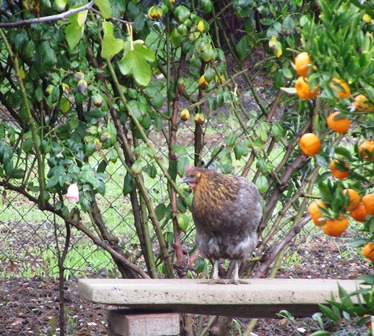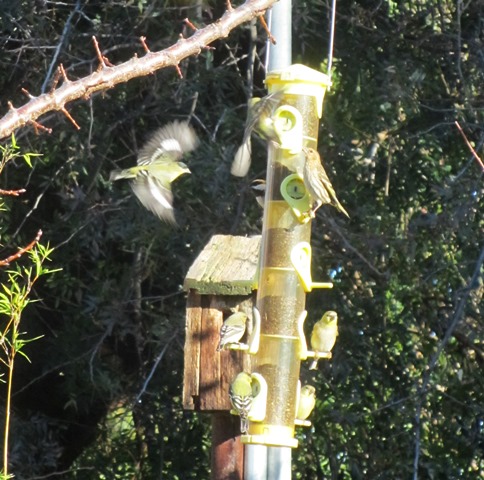Archive for the 'Wildlife' Category
Consumer Concerns Effect Change at Lowe’s and Home Depot
Increasingly, a growing body of science points to the role of bee-toxic pesticides (specifically neonicotinoids) in the global decline of the honeybee populations.
Lowe’s Home Improvement stores announced it will begin to phase out neonicotinoid pesticides (neonics are a class of pesticides harmful to bee health) as soon as suitable alternatives become available. The retailer will also provide customers with more educational materials focusing on pollinator health.
Home Depot has pledged to begin labeling plants on which neonicotinoids have been used. Other retailers are responding to consumer concerns as well.
East coast-based BJ’s Wholesale Club intends to require vendors to label plants free of neonicotinoids; otherwise vendors must label plants on which neonics have been used with a “caution around pollenators” tag.
Ten other retailers in states from California, Colorado, Minnesota, and Maryland have plans to limit or eliminate neonics.
A study published in the Journal Environmental Science and Pollination Research revealed that there is clear evidence that the use of neonicotinoid pesticides are a key factor in honeybee decline.
Letting Gardens Dry Up Is Hard On the Honeybees
My neighbor, a world-class beekeeper whose honey sells to many specialty markets and also Whole Foods, told me today honeybees in backyard hives in our East Bay communities are hungry. He has put out two five-gallon cans of sugar water to feed his bees.
Interestingly, I’ve noted bees at my hummingbird feeders also usurping the sugar water meant for the hummingbirds.
The honeybees do not make honey from sugar water. They just consume it to have energy to forage for pollen and to cool the hives on hot days. The drought means people are watering less; flower gardens and local landscape are dry, and in places the clay soil is cracking open. Bad news for bees.
Weatherwise, it’s been triple-digit hot and then cold and cloudy. I guess the bees will adapt but old timers say, “A swarm in July means bees go bye-bye.” This isn’t the right time for swarming.
My hived bees are loud and energetic. The bees faked me out with a small swarm about ten days ago and then returned to the hive; and now they are eating sugar water for energy to gather what pollen they can find to make honey. The honey will see the hungry hive through until the star thistle and the fall eucalyptus blooms. I’m torn between letting my bee-loving flowers dry up to conserve water, but I don’t want to lose my bees.
Why You Should Never Leave the Farmhouse Door Open
I unlatched the hen house door to let the birds out for the day. Then I filled water basins for my chickens, honeybees, and farmette wildlife. Finally, with chores done, I returned to the farmhouse to work on my new book.
Lost in a tense winter scene for novel number three, I wrote until I heard the chickens cackling as they do when they lay an egg or are frustrated because they can’t get the nesting box already occupied by another hen. And of late, that happens often because one of my Wyandotte chickens has gone broody. She’s sitting on two dozen eggs and it’s futile since we don’t have a rooster. Those eggs will never hatch.
As the cackle grew louder. I stopped typing to peer out the window next to my desk. Nothing seemed out of the ordinary, but on the off chance that a skunk, fox, chicken hawk, or other predator had invaded the yard or the hen house, I got up. I had to check.
By now the cackle had become deafening. I thought the chicken might be at the back door. As I turned from my computer to walk down the hall past my bedroom, I saw my Rhode Island Red directly in my path. Her cackle could wake the dead. So why was she making such a ruckus.
Then I saw it–a dollop of chicken poop on my new hardwood floor. She must have known I’d be furious. And she’d been trying to tell me something. I swooped her up and carried her outside, making a mental note to always check the door on the farmhouse. My office is no place for a chicken.
What to Do When Ants Invade the Honey Bucket
My five-gallon honey bucket with the spigot makes it easy for me to fill up a jar of honey for friends or family. For easy access, I keep it on a round table in the kitchen.
Yesterday morning, I went to refill our own empty jar and noticed ants on the exterior of the bucket. It has a lid on it, but not too tight-fitting, so I held my breath and pulled off the lid.
Removing the lid, I found the ants had infiltrated it and hundreds floated in the honey. Imagine my dismay.
I consulted with my beekeeper neighbor about what to do with the now-unusable honey. Much to my surprise, he said save it. He told me to put it in the freezer (the one specifically used to freeze frames and therefore kill any pests we can’t see on the wax before returning those frames to the hives). So the bucket with the ants went into the freezer I keep on the patio.
My neighbor says the ants will die. The bees can then eat that honey when there isn’t enough pollen around, for example, during the winter. It’s a win-win . . . except for the ants.
A False Swarm . . . Sort Of
When I heard my neighbors banging on a pan with a wooden spoon, I sprang into action. It is what we do when a honeybee hive swarms.
As it turned out, my bees had swooped from the hive with their queen into the front yard, past the plum tree and were circling above the blood orange. My neighbors, who were in their courtyard, saw it and began the banging to confuse the bees so they would alight close to their home.
I ran out and, with direction from my beekeeper neighbor, placed the hive near the orange tree. I’d already placed eight frames with wax and my neighbor brought over two with honey on the comb. All seemed to go as planned. We shook the tree and the bees dropped into the prepared hive.
My neighbor went home, and I went back to my computer and the novel I’m writing. Thirty minutes later, the bees were swarming again. I ran out and banged on the pan. They settled down. All seemed well, except for ants that had been in the orange tree and now were in the hive box.
Around nine o’clock at night, I sprayed the outside of the hive with Windex and wiped it with paper towels. I repeated the procedure around the perimeter of the box, replaced the lid, and carried the hive box back to the apiary believing all would be well. It wasn’t.
This morning, I ran out and suited up in my beekeeper’s outfit and gloves, opened the new hive box, and looked in. To my dismay, all the bees were gone.
My neighbor later told me over coffee that the bees had likely returned to their old hive as small swarms sometimes do. So . . . I suppose I may be repeating this whole scenario at some point in the days ahead. My neighbor reminded me that the weather has been strange, and the weather affects the bees’ behavior.
What’s Eating the Chicken Eggs?
Several times over the last month or so, I’ve traipsed to the hen house to collect eggs and found a broken egg or one with a hole in the shell and the egg otherwise intact.
I wondered if one of the chickens had gone rogue and was pecking the egg that either she or one of the other hens had laid.
My flock is small and they usually lay their eggs during the morning hours, using the afternoon to free range and forage.
Each time I heard a cackle, I sprinted to the chicken house to see who was raising the ruckus and whether or not she’d pecked her egg.
Finally, I caught one of my Silver-Lace Wyandotte hens on the nest. With her head twisted behind and under her wing, I could not tell what was going on. I slipped my hand under her, causing her head to jerk around. It appeared I had caught her in the act as her beak was covered with yolk.
So I thought I’d solved the mystery. My solution was to remove each egg as soon as the hen laid it. If I removed the eggs, any temptation for the chickens to peck the eggs would be eliminated, too. But running for every chicken squawk became so time consuming, I finally stopped.
To my utter surprise, there were no more broken eggs. That didn’t make sense. However, during the whole ordeal with the broken eggs, I’d been smelling a skunk. When my closest neighbor said a skunk had been raiding his coop for the eggs, I began to think I had wrongly accused my poor Wyandotte.
Indeed, since my neighbor took care of the skunk (by trap, I believe), my hens are producing eggs every day and none have holes or are cracked. I’m now thinking the skunk was the egg robber.
That experience got me thinking about other predators that will eat chicken eggs (and chickens, too). The list includes opossums, weasels, rats, snakes, minks, foxes, wild dogs, coyotes, raccoons, hawks, and owls. So, even if I’ve got a nice hen house and a run with a wire roof, it seems that a predator motivated by a good meal with find a way in.
The Prolapsed Vent Issue
It happened to one of my chickens a few years ago; now, it’s happened again.
My one-year-old Ameraucana hen–a blue-egg layer–developed a prolapsed vent from trying to lay a too-large egg. The first time it happened, I did all the things I’ve learned to do: separate her from the flock, reduce light, nutrition, and water (to stop her from trying to lay more eggs).
I used a lukewarm towel to clean her. Latex gloves and vaseline to try to push the vent/cloaca back in. And it worked for a while. It took her a couple of weeks to recover. Elated, I thought she would be fine. Not so.
By the time I realized it had occurred again, the other chickens had been pecking her–drawing blood–and she seemed weak, wobbly, and near death. I repeated the previous steps, thinking she’d pull out of it, but by morning she was gone.
Disheartened, I began to search chicken forums on the Internet to find out which breeds are susceptible to this issue. I learned the Cornish game hens and chickens that are bred for meaty bodies are more likely to have the vent prolapse, but I haven’t yet learned whether or not the Ameraucanas are equally susceptible. If anyone knows, drop me a line. Thanks.
Flowers, Nest-Building, and Bee Swarms . . . Spring Has Arrived
The wisteria hangs in long purple bracts, its color finding resonance in the grape hyacinth blooms and the lavender buds. Delicate blossoms of pink and white create canopies of color for the fruit trees, and birdsong fills the air. Spring brings its gifts.
As the blue jay creates a screeching racket to the mockingbird’s ready song, the white-crowned sparrows have taken up residence in a row of birdhouses we’ve placed high on the back fence.The entrances of the sparrow houses are too small for the jay to access; a good thing since jays have earned a reputation as nest robbers.
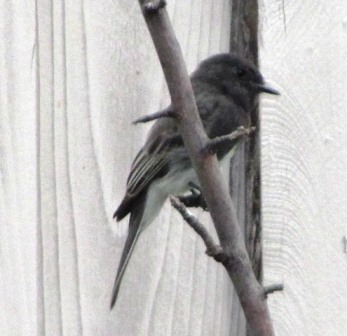
Crew Cut, our resident black phoebe, nests under an eve of the old chicken house; the male teaches its young to catch insects on the wing
Yesterday, I spotted the black phoebe pulling a piece of coir from a wall planter for its nest. These peaceful birds make a sound of tsip or fi-bee, fi-bee and can rise to roughly 50 feet to sing to a female.They range from California to central Texas, and even venture all the way to Argentina.
In the tallest eucalyptus on the acre that stands vacant behind our property, a pair of hawks are also nest-building. My farmette lies in their flight path. Not a good thing to see–hawks swooping down over my chickens and then rising to their lofty nest.
I threw some wildflower seed in beds over the weekend and then, after spotting my neighbor’s errant hen who flew to our yard, I began to regret my action. What can I do now but hope that she’ll not devour the seeds with her constant hunting and pecking?
Last night, I could have sworn I heard the pitter-patter of raindrops against the stone patio floor. With a steaming mug of coffee in hand at four o’clock this morning, I ventured outside and sure enough . . . it was still sprinkling. Hooray! It’s our first spring shower!
So, with all the nest-building and Mother Nature dropping a shower upon us, I know the wildflowers are blooming, too. That means the honeybee season is upon us. My neighbor has already had a bee swarm. I’m not ready, but I can’t stop Mother Nature from beginning a new cycle of seasons just because I don’t yet have my new honey frames assembled. That’s not how it works. Ready or not, spring has arrived.
Working the Beds after the Weekend Storm
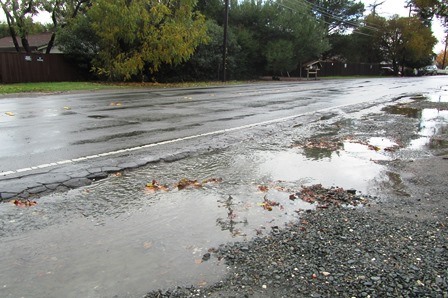
A “Pineapple Express” rainstorm with gale-force winds blew out the power and made for slick roads as well as ponds in our clay soil
The weekend storm is still a vivid memory, what with the fence along one side of my property beaten down by high winds and pounding rain that also brought a power outage on Friday night.
But today with outside temperatures in the 70s Fahrenheit, I cleaned my strawberry beds. Somehow, mint had crept in and I don’t want mint with my berries although I like it served that way for dessert.
My neighbor’s relative, who’s visiting from Lebanon where they grow apples in his mountain village, share a suggestion for digging dried chicken manure around the bases of my trees. The high nitrogen will get them off to a great start and my trees have already broken bud (which is attracting the honeybees).
The wild bird population seems to have exploded and I see signs of nest building starting. The five suet cakes I hung in trees for the songbirds, blue jays, and woodpeckers last month are down to a fraction of their original size.
I extended the chicken run with poultry wire high enough to keep the my heritage girls from flying out. Now, they’ll have plenty of space on both sides of the chicken house to forage and out the beds I’m working.
Helping the Wildlife Make It through Winter
Our farmette has been experiencing traffic congestion from the wild birds flying in to dine at the feeders that I’ve recently filled.
I’ve also hung seeded suet cakes (especially favored by the Nuttal’s Woodpecker who knows exactly where the snack is hanging on the back fence).
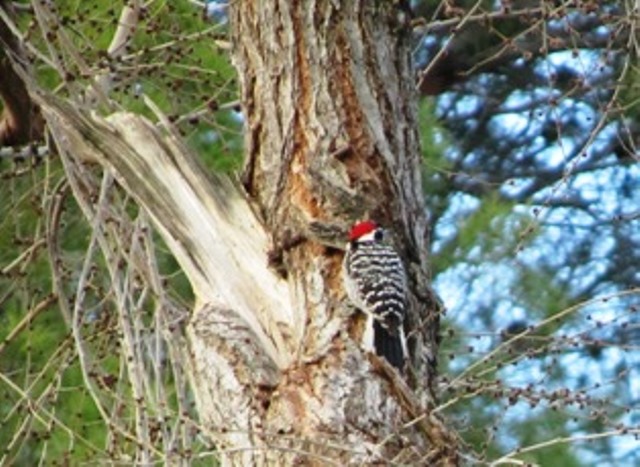
The Nuttall’s Woodpecker appears as a dash of brilliant red with black-and-white stripes wherever it perches
There are hawks doing fly-overs and blue jays flitting from the bushes to the trees.
But I especially love the little wild bird we call Crew Cut, a black phoebe that is building a nest in one of my apricot trees. And today, I spotted a Western bluebird on the fence at the front of our property.
This time of year when there is little for birds to forage on, I believe in providing bird seed, suet cakes, sunflower seeds, and peanuts for our feathered friends. I love to see them at the feeders and hope they’ll stay around to build nests in the spring.
 Facebook
Facebook Goodreads
Goodreads LinkedIn
LinkedIn Meera Lester
Meera Lester Twitter
Twitter



